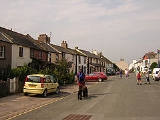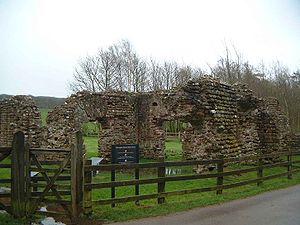
Ravenglass
Encyclopedia
Ravenglass is a small coastal village and natural harbour in Cumbria
, England
. It is the only coastal town within the Lake District National Park
. It is located at the estuary of three rivers: the Esk
, Mite
and Irt
 The town dates back to at least the 2nd century, when it was an important naval base for the Romans
The town dates back to at least the 2nd century, when it was an important naval base for the Romans
now believed by experts to have been 'Tunnocellum' although it is often popularly named Glannoventa. It occupied the most southerly point of the Cumbrian coastal defence system, an extension of Hadrian's Wall
, connected by a continuous chain of milefortlets
and watchtowers. Ravenglass was occupied by the Romans for over 300 years and had a garrison
(castra
) of 500 soldiers. The town was a regional supply point for much of north-western Roman Britain, with a Roman road from Ravenglass over the Hardknott Pass
to the Roman fort at Ambleside
. The location is featured in The Fort at River's Bend, a book in Jack Whyte
's A Dream of Eagles
(Camulod Chronicles) series, and is also mentioned briefly in Mary Stewart
's Merlin
trilogy under the name Clannoventa. Today, there are few Roman remains, with the notable exception of a bath-house
, known locally as Walls Castle. This is one of the largest remaining Roman structures in England, covering an area of 90 feet by 40 feet and with walls up to 12 feet high. The property is now maintained by English Heritage
and form the western extremity of the Roman frontier World Heritage Site.
'Renglas' appears in charters and other records of the late 12th century. In 1208 King John granted Richard de Lucy
, Earl of Egremont
a Charter for a Market at Ravenglass on Saturdays and a yearly fair on the festival of St. James, August 5.
and the Ravenglass and Eskdale Railway
.
trunk road and Ravenglass railway station on the Cumbrian Coast railway line
. It is also a terminus for the Ravenglass and Eskdale Railway
, a popular tourist attraction.
Cumbria
Cumbria , is a non-metropolitan county in North West England. The county and Cumbria County Council, its local authority, came into existence in 1974 after the passage of the Local Government Act 1972. Cumbria's largest settlement and county town is Carlisle. It consists of six districts, and in...
, England
England
England is a country that is part of the United Kingdom. It shares land borders with Scotland to the north and Wales to the west; the Irish Sea is to the north west, the Celtic Sea to the south west, with the North Sea to the east and the English Channel to the south separating it from continental...
. It is the only coastal town within the Lake District National Park
Lake District National Park
The Lake District National Park is located in the north-west of England and is the largest of the English National Parks and the second largest in the United Kingdom. It is in the central and most-visited part of the Lake District....
. It is located at the estuary of three rivers: the Esk
River Esk, Cumbria
The River Esk is a river in the Lake District in Cumbria, England. It is one of two River Esks in Cumbria, and not to be confused with the River Esk which flows on the Scottish side of the border....
, Mite
River Mite
The River Mite is a river in the county of Cumbria in northern England.The valley through which the river Mite runs is called Miterdale. The name Mite is thought to be of British origin and related to a root such as 'meigh': to urinate or dribble, possibly a wry reflection of the relatively minor...
and Irt
River Irt
The River Irt is a river in the county of Cumbria in northern England. It flows from the south-western end of Wast Water, the deepest lake in England, leaving the lake at the foot of Whin Rigg, the southern peak of the famous Wastwater Screes....
History

Ancient Rome
Ancient Rome was a thriving civilization that grew on the Italian Peninsula as early as the 8th century BC. Located along the Mediterranean Sea and centered on the city of Rome, it expanded to one of the largest empires in the ancient world....
now believed by experts to have been 'Tunnocellum' although it is often popularly named Glannoventa. It occupied the most southerly point of the Cumbrian coastal defence system, an extension of Hadrian's Wall
Hadrian's Wall
Hadrian's Wall was a defensive fortification in Roman Britain. Begun in AD 122, during the rule of emperor Hadrian, it was the first of two fortifications built across Great Britain, the second being the Antonine Wall, lesser known of the two because its physical remains are less evident today.The...
, connected by a continuous chain of milefortlets
Milecastle
A milecastle was a small fort , a rectangular fortification built during the period of the Roman Empire. They were placed at intervals of approximately one Roman mile along several major frontiers, for example Hadrian's Wall in Great Britain , hence the name.Along Hadrian's Wall, milecastles were...
and watchtowers. Ravenglass was occupied by the Romans for over 300 years and had a garrison
Garrison
Garrison is the collective term for a body of troops stationed in a particular location, originally to guard it, but now often simply using it as a home base....
(castra
Castra
The Latin word castra, with its singular castrum, was used by the ancient Romans to mean buildings or plots of land reserved to or constructed for use as a military defensive position. The word appears in both Oscan and Umbrian as well as in Latin. It may have descended from Indo-European to Italic...
) of 500 soldiers. The town was a regional supply point for much of north-western Roman Britain, with a Roman road from Ravenglass over the Hardknott Pass
Hardknott Pass
Hardknott Pass is a pass that carries a minor road between Eskdale and the Duddon Valley in the region of Cumbria, England, in the Lake District National Park...
to the Roman fort at Ambleside
Ambleside
Ambleside is a town in Cumbria, in North West England.Historically within the county of Westmorland, it is situated at the head of Windermere, England's largest lake...
. The location is featured in The Fort at River's Bend, a book in Jack Whyte
Jack Whyte
Jack Whyte is a Scottish-Canadian novelist of historical fiction. Born and raised in Scotland, Whyte has been living in Canada since 1967. He resides in Kelowna, British Columbia....
's A Dream of Eagles
A Dream of Eagles
A Dream of Eagles is a historical novel series written by the Canadian author Jack Whyte. It was published in the United States as the Camulod Chronicles....
(Camulod Chronicles) series, and is also mentioned briefly in Mary Stewart
Mary Stewart
Mary Florence Elinor Stewart is a popular English novelist, best known for her Merlin series, which straddles the boundary between the historical novel and the fantasy genre.-Career:...
's Merlin
Merlin
Merlin is a legendary figure best known as the wizard featured in the Arthurian legend. The standard depiction of the character first appears in Geoffrey of Monmouth's Historia Regum Britanniae, written c. 1136, and is based on an amalgamation of previous historical and legendary figures...
trilogy under the name Clannoventa. Today, there are few Roman remains, with the notable exception of a bath-house
Ravenglass Roman Bath House
Ravenglass Roman Bath House is one of a few surviving structures from a 2nd century Roman fort and naval base. Described by Matthew Hyde in his update to the Pevsner Guide to Cumbria as "an astonishing survival", the still standing walls are 13 ft high...
, known locally as Walls Castle. This is one of the largest remaining Roman structures in England, covering an area of 90 feet by 40 feet and with walls up to 12 feet high. The property is now maintained by English Heritage
English Heritage
English Heritage . is an executive non-departmental public body of the British Government sponsored by the Department for Culture, Media and Sport...
and form the western extremity of the Roman frontier World Heritage Site.
'Renglas' appears in charters and other records of the late 12th century. In 1208 King John granted Richard de Lucy
De Lucy
de Lucy or de Luci is the surname of an old Norman noble family originating from Lucé in Normandy, one of the great baronial Anglo-Norman families which became rooted in England after the Norman conquest. The first records are about Adrian de Luci who went into England after William the Conqueror...
, Earl of Egremont
Earl of Egremont
Earls of Egremont was a title in the Peerage of Great Britain. It was created in 1749, along with the subsidiary title of Baron Cockermouth, for Algernon Seymour, 7th Duke of Somerset, with remainder to his nephews Sir Charles Wyndham, 4th Baronet, of Orchard Wyndham, and Percy Wyndham-O’Brien...
a Charter for a Market at Ravenglass on Saturdays and a yearly fair on the festival of St. James, August 5.
Attractions
Famous attractions include Muncaster CastleMuncaster Castle
Muncaster Castle is a privately owned castle overlooking the Esk river, about a mile south of the west-coastal town of Ravenglass in Cumbria, England.-History:...
and the Ravenglass and Eskdale Railway
Ravenglass and Eskdale Railway
The Ravenglass and Eskdale Railway is a minimum gauge heritage railway in Cumbria, England. The line runs from Ravenglass to Dalegarth Station near Boot in the valley of Eskdale, in the Lake District...
.
Access
Today, the town is served by the A595A595 road
The A595 is a primary route in Cumbria, in northern England that starts in Carlisle, passes through Whitehaven, and goes close to Workington, Cockermouth and Wigton. It passes Sellafield and Ravenglass before ending at the Dalton-in-Furness by-pass, in southern Cumbria, where it joins the A590...
trunk road and Ravenglass railway station on the Cumbrian Coast railway line
Cumbrian Coast Line
The Cumbrian Coast Line is a rail route in North West England, running from Carlisle to Barrow-in-Furness via Workington and Whitehaven. The line forms part of Network Rail route NW 4033, which continues via Ulverston and Grange-over-Sands to Carnforth, where it connects with the West Coast Main...
. It is also a terminus for the Ravenglass and Eskdale Railway
Ravenglass and Eskdale Railway
The Ravenglass and Eskdale Railway is a minimum gauge heritage railway in Cumbria, England. The line runs from Ravenglass to Dalegarth Station near Boot in the valley of Eskdale, in the Lake District...
, a popular tourist attraction.
External links
- Ravenglass Community website

